
As the Chinese New Year nears, trading activity in the nickel sulfate market has slowed, with most companies having already completed their procurement. Only a few downstream enterprises continue to make purchases. Amid margin inversions, producers have started to reduce production while holding prices and stockpiling. Additionally, Indonesia’s recently announced nickel ore quota has restricted production, creating challenges in meeting demand for 2025.
On January 10, 2025, Indonesia’s Ministry of Mining set a nickel ore quota of around 200 million wet tonnes for the year, with the possibility of further cuts if miners fail to comply with regulations. This quota falls short of meeting global demand, adding cost pressures to nickel sulfate producers. Indonesia’s policy to support nickel prices has contributed to a rebound in nickel sulfate prices, strengthening cost support for the market.
In China, nickel sulfate production reached 179,400 tonnes in December, equivalent to 39,500 tonnes of nickel content, marking a 3.49% month-on-month increase, according to Mysteel data. The rise in production was primarily due to increased demand for ternary precursor exports and higher nickel cathode output. However, supply for power battery applications remains tight, as inventory levels of available nickel sulfate products are low. Producers are generally unwilling to lower prices, displaying a strong price-holding sentiment.
Demand Fluctuations and Downstream Impact
On the demand side, while some ternary precursor companies ramped up production and advanced overseas shipments in December, overall demand in China for ternary precursors has declined. Leading companies saw limited growth, and many small to medium-sized companies reduced production due to year-end inventory management. The Xiaomi supply chain contributed to steady demand for ternary cathode materials, with slight production increases recorded. However, battery manufacturers have tightened inventory management, leading to a decline in orders for ternary materials.
Nickel sulfate prices are expected to face limited demand growth in January, influenced by the Chinese New Year holiday and efforts by material factories to reduce inventories. Historical price trends indicate a tendency for prices to rise slightly after the holiday. For instance, in 2024, nickel sulfate prices increased from $25,500 per tonne one week before the festival to $27,750 per tonne two weeks after the festival. As of 2025, the average price one week before the holiday stands at $25,750 per tonne.
Despite these factors, the tight spot supply and producers’ unwillingness to lower prices may result in volatile price increases for nickel sulfate after the holiday. The margin inversion between costs and prices is expected to gradually ease, providing some stability to the market.



